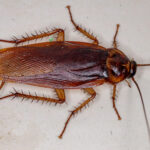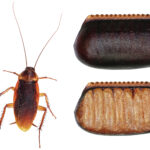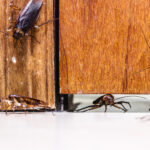How Can We Help?
How do I know if I have a cockroach problem?
Figuring out if you have a cockroach problem means spotting some key signs. The most obvious? Actually, seeing the cockroaches, especially at night when they're most active. If you see even one during the day, it might mean a  bigger infestation, as their hiding spots could be overcrowded. Look out for droppings, which look like small, dark specks or coffee grounds, in places like kitchen cabinets, pantries, or behind appliances. You might also find shed skins or egg cases, which are small, brown, and capsule-shaped. Unpleasant, musty smells can be another clue, especially with larger infestations since cockroaches have a distinct odor. Check for damage to food packaging—cockroaches will chew through it, leaving irregular holes and gnaw marks. Grease marks and smears on walls, counters, and other surfaces where they travel are also telltale signs. At night, listen for rustling or scratching sounds, which can indicate cockroaches moving around. Finally, inspecting dark, moist areas like under sinks, behind refrigerators, and in basements or crawl spaces can reveal their presence. Keeping an eye out for these signs is important, as early detection can stop a minor issue from turning into a major infestation.
bigger infestation, as their hiding spots could be overcrowded. Look out for droppings, which look like small, dark specks or coffee grounds, in places like kitchen cabinets, pantries, or behind appliances. You might also find shed skins or egg cases, which are small, brown, and capsule-shaped. Unpleasant, musty smells can be another clue, especially with larger infestations since cockroaches have a distinct odor. Check for damage to food packaging—cockroaches will chew through it, leaving irregular holes and gnaw marks. Grease marks and smears on walls, counters, and other surfaces where they travel are also telltale signs. At night, listen for rustling or scratching sounds, which can indicate cockroaches moving around. Finally, inspecting dark, moist areas like under sinks, behind refrigerators, and in basements or crawl spaces can reveal their presence. Keeping an eye out for these signs is important, as early detection can stop a minor issue from turning into a major infestation.
Where are cockroaches most likely to be found in the home?
Cockroaches are incredibly adaptable pests that can thrive in various spots around the home, but they tend to favor warm, humid areas with easy access to food and water. The kitchen is a favorite hangout, thanks to its many hiding spots and constant food supply. Check for cockroaches behind and under appliances like refrigerators, stoves, and dishwashers, where crumbs and grease might gather. Cabinets, pantries, and undersinks are also common places because they're close to food and water sources. Bathrooms are another hotspot for cockroaches due to the moisture and warmth. You'll often find them under sinks, behind toilets, and inside cabinets. Basements and crawl spaces offer dark, damp conditions that cockroaches love. Laundry rooms, with their humidity and warmth from appliances, can also attract these pests. Cockroaches might even hide in less obvious places like inside electronics, behind picture frames, and within furniture. They're great at squeezing into tiny cracks and crevices, so you might spot them in wall voids, behind baseboards, and within floor drains. Being nocturnal, they're more active and visible at night. If you see them during the day, it usually means there's a large infestation, forcing them out of their hiding spots. Garages and attics can also harbor cockroaches, especially if they have cardboard boxes, which provide both food and shelter. To minimise the chances of an infestation, keep things clean, fix moisture issues, and seal entry points. If you suspect an infestation, a professional pest control service can help find and get rid of these resilient pests from your home.
How quickly can a cockroach infestation grow?
An infestation can get out of hand quickly thanks to their fast reproductive abilities and the ideal conditions often found in homes. Female cockroaches produce multiple egg cases, called oothecae, throughout their lives, each containing lots of eggs. For example, a single German cockroach, one of the most common household species, can produce up to eight oothecae, each with 30 to 40 eggs. These eggs hatch in about 28 days, releasing nymphs that mature into adults in two to three months. With plenty of food, warmth, and moisture, the population can skyrocket. Starting with just one pair of cockroaches, you could have thousands in just a year. Their rapid growth and ability to hide in small, hard-to-reach places make detection and eradication tough.
containing lots of eggs. For example, a single German cockroach, one of the most common household species, can produce up to eight oothecae, each with 30 to 40 eggs. These eggs hatch in about 28 days, releasing nymphs that mature into adults in two to three months. With plenty of food, warmth, and moisture, the population can skyrocket. Starting with just one pair of cockroaches, you could have thousands in just a year. Their rapid growth and ability to hide in small, hard-to-reach places make detection and eradication tough.
Cockroaches are nocturnal and avoid light, so if you see one during the day, there might already be a significant infestation. Their quick reproduction means that even a small initial population can become a big problem fast. Plus, cockroaches can survive on very little, eating crumbs, grease, and even non-food items like glue and soap. They are also resilient to many control measures, making it even harder to manage an infestation.
Environmental factors matter, too. Warmer climates and homes with high humidity levels are perfect for cockroach breeding. They love cluttered environments with plenty of hiding spots, making it easier for them to stay hidden and multiply unnoticed.
What are the biggest risks and dangers of allowing a cockroach infestation to grow out of control?
Letting a cockroach infestation get out of hand can lead to serious health risks. Cockroaches carry various pathogens, like Salmonella and E. coli, which can contaminate food and surfaces, causing food poisoning, dysentery, and other stomach issues. Their droppings, shed skin, and saliva have allergens that can aggravate asthma and allergic reactions, especially in kids and sensitive people. Plus, the allergens they spread can worsen respiratory problems.
 On top of health concerns, they also give off a musty smell that gets worse with bigger infestations, and this odour can seep into food, fabrics, and other items in the house.
On top of health concerns, they also give off a musty smell that gets worse with bigger infestations, and this odour can seep into food, fabrics, and other items in the house.
A bad cockroach infestation can also mess with your mental well-being, causing stress, anxiety, and embarrassment. The stigma of an uncontrolled infestation can affect social interactions and overall quality of life. To avoid these issues, it's important to hire professionals like us here at Youngs Pest Control to tackle cockroach infestations quickly and effectively.
